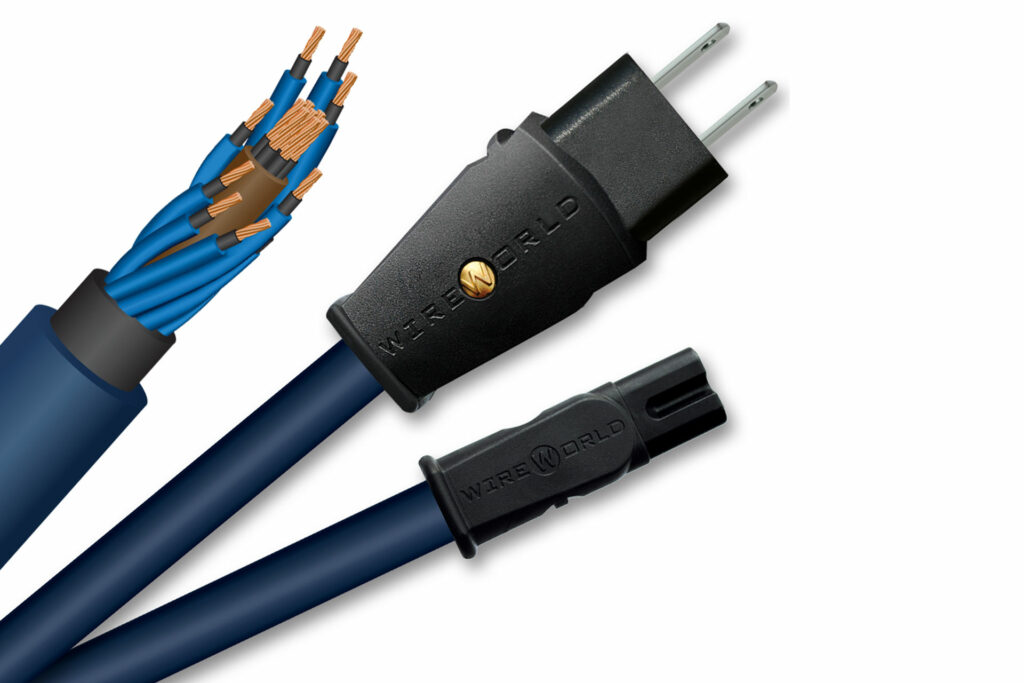Wireworld Cable Technology today announced the release of their Stratus™ and Electra™ Shielded Mini Power Conditioning Cords. These cords feature a new conductor geometry that provides shielding and isolation from external interference. They’re called ‘Power Conditioning Cords’ because they extend the functions and benefits of power conditioning all the way to the component’s power inlet.
“Two-conductor cords power our TVs and many other components, but previous two-conductor power cords have not been effective at rejecting interference,” comments Wireworld designer and President David Salz. “In blocking most interference, these cords make surprising audible and visible improvements.”
Stratus and Electra Shielded Mini Power Cords are flexible enough to use with small components, like streamers, wireless speakers and TV soundbars. Their individually insulated conductors add up to 16AWG (1.25mm2) per polarity. The conductor material in Stratus is oxygen-free copper, while Electra’s conductors are made of the highest purity Ohno Continuous Cast® (OCC-7N) copper. Their premium quality figure-8 plugs and wall plugs feature supremely conductive silver-clad contacts for measurably quieter connections than other metals. The filtering effect of the cords is enhanced by Wireworld’s ultra-quiet COMPOSILEX insulation. The new conductor geometry is an extension of Wireworld’s exclusive Tite-Shield™ technology, which reduces interference to improve image and sound quality.
Retail Pricing
Both cables are available now in lengths of 1m, 1.5m and 2m.
Stratus Shielded Mini Power Cord: $70/1m, $80/1.5m, $90/2m
Electra Shielded Mini Power Cord: $160/1m, $200/1.5m, $240/2m

The Audiophile History of Wireworld Cables
Wireworld is one of the most established names in the world of audiophile cables, and it didn’t get there by leaning into marketing gimmicks or pseudo-scientific jargon. The brand’s legacy is rooted in engineering, research, and a willingness to challenge long-standing assumptions about how signal transfer happens in audio systems. At the center of that story is David Salz, Wireworld’s founder and chief designer—an audio obsessive who decided early on that if he was going to make cables, they had to prove their worth not just by ear, but by measurement and comparison.
The Wireworld story starts in the early 1990s, during a period when high-end audio cables were becoming more visible, more expensive, and—depending on your view—more controversial. The market was filled with brands claiming night-and-day improvements, often without much explanation. Salz wasn’t having it. His approach was straightforward: develop cables that were demonstrably more transparent, using controlled tests, repeatable metrics, and a deeper understanding of electromagnetic behavior.
Rather than relying on listening alone, Salz developed what he called the “Cable Comparator”—a system that allowed A/B comparisons between a direct connection and a cable connection in real time. This setup eliminated memory bias and delayed perception, letting listeners (and himself) evaluate how much, if anything, a cable was adding or taking away from the source signal. Through this method, he learned that even short lengths of cable could subtly—but measurably—affect sound.
From that foundation, Salz developed Wireworld’s DNA Helix design—an approach that reduces electromagnetic loss and preserves phase integrity by controlling the geometry of the conductors with extreme precision. The idea was to move beyond typical twisted-pair or coaxial designs and create cable structures that actually behaved more like a direct connection electrically. This attention to geometry, conductor material, and insulation became the core of the Wireworld design philosophy.
One of the key differences with Wireworld cables is their flat, ribbon-like shape, which isn’t just a design choice—it’s functional. The geometry is optimized for signal transfer, and in higher-end models, the conductor materials include OCC (Ohno Continuous Cast) copper and silver-clad variants, which offer extremely high conductivity and low distortion at audio frequencies.
Wireworld began with analog interconnects and speaker cables, and quickly built a reputation for producing clean, neutral-sounding cables that didn’t hype or dull the system. But the company’s real breakout came when they started applying the same rigor to digital cables—AES/EBU, coaxial, USB, HDMI, and even Ethernet. While many audiophiles dismissed digital cable design as irrelevant (“it’s just ones and zeroes”), Salz approached it from the standpoint of timing, jitter, and signal integrity. He argued that minimizing loss and reflections in the cable could reduce error correction activity, leading to cleaner, more consistent digital playback. Whether or not you buy into the full theory, the results spoke for themselves—many listeners heard tangible differences when switching to Wireworld digital cables, especially in resolving systems.
In the last two decades, Wireworld has expanded its lineup into nearly every major cable category: power cords, HDMI, USB, Ethernet, optical, tonearm cables, and even headphone cables. But the consistency has been in the voicing—neutral, open, and engineered to preserve what’s upstream without editorializing.
Wireworld doesn’t make “flavor” cables. They’re not designed to warm up a bright system or soften harsh digital edges. They’re designed to get out of the way, revealing what your components are actually doing. That’s not a marketing slogan—that’s David Salz’s design brief, and it’s one that hasn’t changed much since the early ’90s.
The brand also avoids the kind of hyperbole that turns off rational listeners. Wireworld doesn’t talk about cables as “components” or lean into magic dust theories. Instead, they publish test data, show waveform comparisons, and invite skeptics to listen for themselves. In a space where credibility can be hard to maintain, that engineering-first transparency has kept them relevant.



